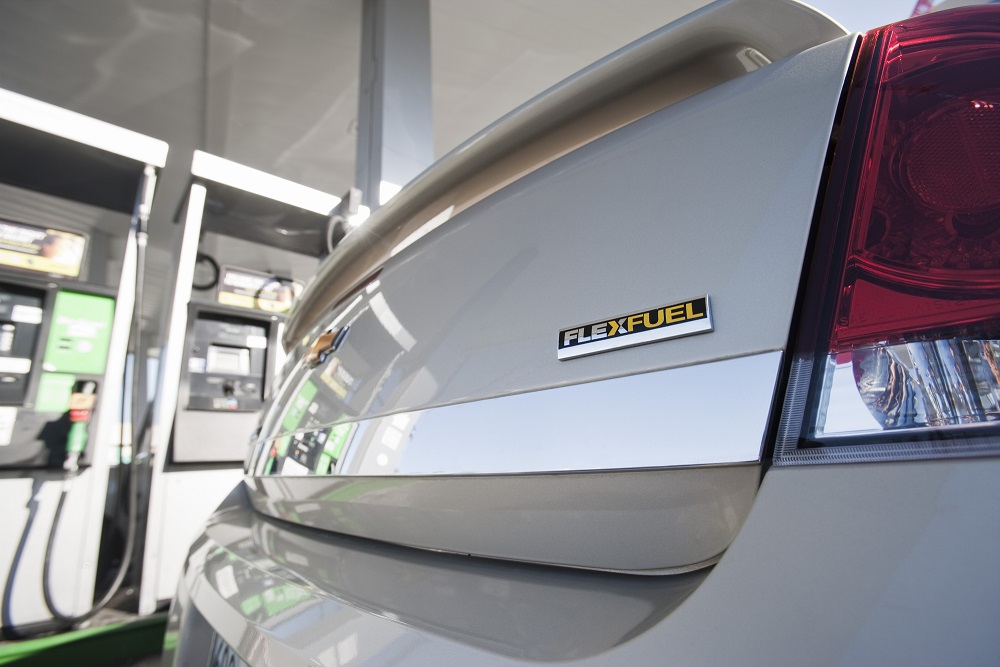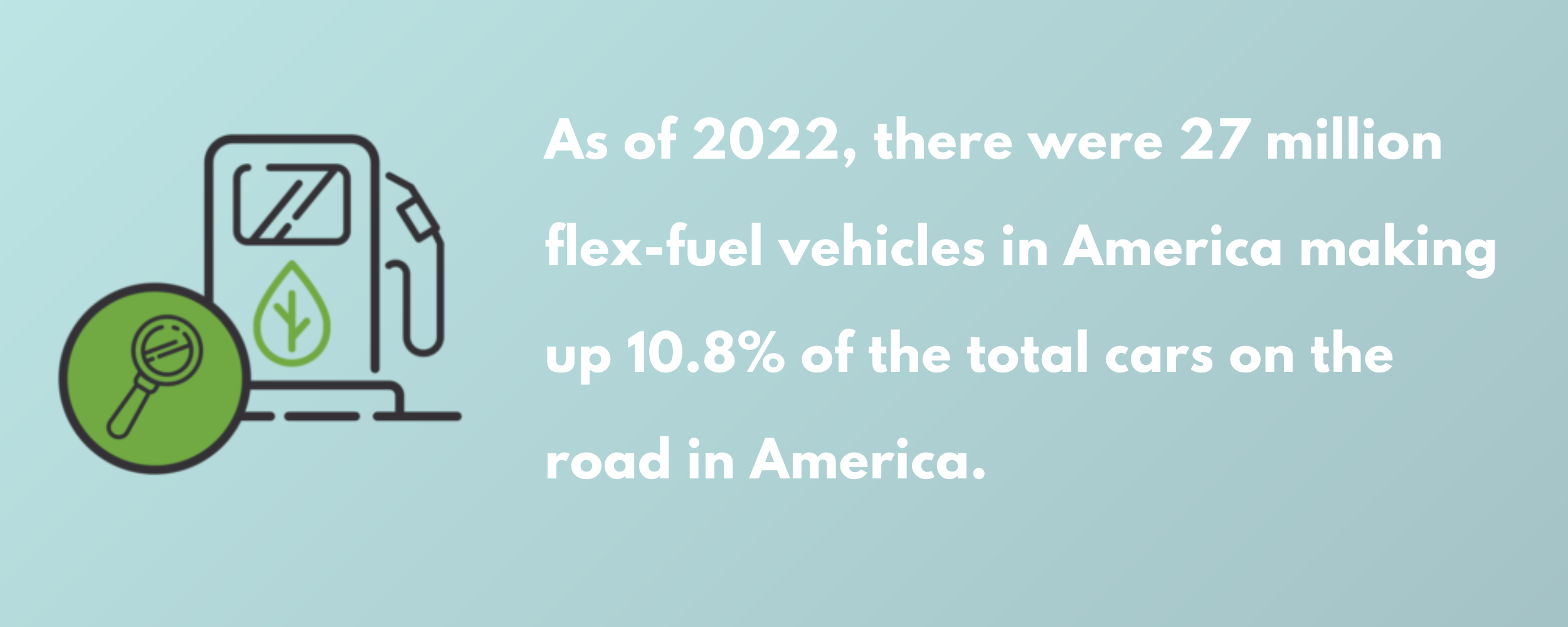
Flex-fuel vehicles, or FFVs aren’t new… in fact, the technology has been in use for the past 27 years. Despite the early start and benefits, FFVs didn’t get mainstream acceptance as an EV or hybrid vehicles. Politics, government policies, and inherent drawbacks of biofuels have all contributed to the slow growth of the FFVs market. While on one side, demand for cleaner fuel is on the rise, the diminishing financial incentives for automakers to manufacture FFV is preventing mass adoption.
What are Flexible-fuel Vehicles (FFV)?
Simply put, Flex-fuel vehicles are flexible on the kind of fuel they can consume. FFVs can run on regular gasoline and E85 (or flex-fuel). E85 is a blend of gasoline and 51 to 83% anhydrous ethanol. The actual percentage of ethanol varies depending on the state and season. Most FFVs are designed to work with fuel containing 0 to 83% ethanol.
The sole difference between an FFV and a conventional vehicle is that an FFV can run on regular gasoline or E85 flex fuel. However, the reverse is not true – a regular gasoline-powered car can’t run on E85.
FFVs have a similar internal combustion engine to regular gasoline cars but also have a few modifications to make them compatible with E85 and other blends. An ethanol sensor calibrates the fuel-air mixture, and the fuel system doesn’t contain rubber, aluminium or magnesium parts due to the corrosive nature of the ethanol.
Now that we have a basic understanding of FFVs let’s take a look at some key facts about FFVs:
- As of 2022, there were 27 million flex-fuel vehicles in America.
- Flex-fuel vehicles make up 10.8% of the total cars on the road in America.
- The United States is the second-largest flex-fuel vehicle market, behind Brazil.
- EIA estimates by 2035, 19.2% of the vehicles in America will be FFVs.
- Globally, it’s estimated that there are 75 million flex-fuel vehicles.
- FFVs running on E85 reduce GHG (Greenhouse gases) emissions by up to 34% compared to regular vehicles.
- FFVs operating on E85 fuel report up to 25% poor mileage compared to gasoline vehicles. That said, E85 flex-fuel is about 22% cheaper than traditional gasoline.
- In America, Ethanol is derived from corn, and about 40% of the corn production is used for producing ethanol.
- There are 4,200 public E85 fuel stations in the United States (2022).
- Most FFV vehicles have a yellow fuel cap or a yellow ring around the fuel-filler neck to indicate they can use E85 and other flex fuels.
- Flex-fuel vehicles are predominantly popular in the midwest states due to lower E85 fuel prices (closer proximity to refineries).
- In 2015, there were 85 FFV models for sale, down to just 17 in 2022. The lack of financial incentives has been the primary reason for this significant drop.
- Today only Ford, Chevrolet and General Motors are selling flex-fuel vehicles in America.
- Introduced in 1908, Ford Model T was the first flex-fuel vehicle. It could run on ethanol, gasoline and kerosene fuel.

Flex-Fuel Vehicle Statistics (2023)
America is the second largest Flex-fuel Vehicle market in the world, with a share of 36%.
America had around 27 million flex-fuel vehicles in 2022, just behind Brazil, which had 34 million. Canada (2.1 million) and Europe (1.4 million) are other major markets. Globally 95% of the FFV market is concentrated in Brazil, the United States, and Canada.
Only 3% of fuel stations sell E85 in the United States.
The National Association of Convenience Stores (NACS) estimates there are 145,000 public fuel stations in the United States, with just 4,200 selling E85 fuel. What’s even more striking is that a major junk of E85 fuel stations are concentrated in the midwest states, especially Minnesota
Flex-fuel vehicles running on E85 produce up to 34% less GHG (Greenhouse gas) than regular vehicles.
Flexi-fuel vehicles are cleaner for the environment. The E85 fuel used in FFVs emits significantly fewer greenhouse gases than traditional gasoline. Studies estimate E85 fuel results in up to 34% less GHG emissions than gasoline. Further, as per Argonne National Laboratory, E85 fuel reduces emissions by an average of 40% on a lifecycle basis.
Flex-fuel vehicles operating on E85 get up to 25% fewer miles per gallon than gasoline cars.
Depending on the Ethanol content, FFVs running on E85 fuel report up to 25% poorer mileage than regular gasoline vehicles. However, on average, E85 fuel is 22% cheaper than regular gasoline (the price of E85 fuel varies significantly based on the time of the year and location).
With that said, E85 fuel is cheaper per gallon but slightly more expensive per mile when compared to gasoline. So FFVs operating on E85 fuel end up slightly costlier than regular cars in terms of fuel costs.
The number of Flex-fuel vehicle models is rapidly declining.
In 2022 only 13 FFV models from three automakers, Ford, Chevrolet and General Motors were available for sale in the United States. This is much lower than the 85 FFV models that were available back in 2015.
As per Alternative Fuels Data Center (AFDC), 2023 follows a similar declining trend, with only 9 FFV models available for sale.
The decline can be attributed to the diminishing financial incentive by the government for automakers, the lack of E85 infrastructure and the rise of electric and hybrid vehicles.
FFV vehicles have relatively lower repair and maintenance costs.
Flex-fuel vehicles are relatively cheaper to maintain and repair when compared to regular cars. E85 fuel naturally cleans the engine, burn cooler and leaves lesser carbon residue. All this helps lower overall maintenance costs for FFVs running on E85 fuel.
FFVs produce up to 20% more power on E85 fuel.
FFVs running on E85 fuel produce more power than regular gasoline vehicles meaning there is improved acceleration and lesser engine knocking. The E85 fuel has an octane value of 100-105 compared to regular gasoline, which has an octane value of 87-94.
Due to the highest available octane value, E85 fuel is often used in race cars and other high-performance vehicles.
Wrapping Up
Will Flex-fuel vehicles be the future of the automobile industry? It’s difficult to say. However, what is certain is that FFVs are eco-friendly and somewhat cut our dependency on imported fossil fuels. If EIA’s prediction is anything to go by – by 2035, FFVs will account for 19.20% of the total vehicles in America. The future looks bright for FFVs.
